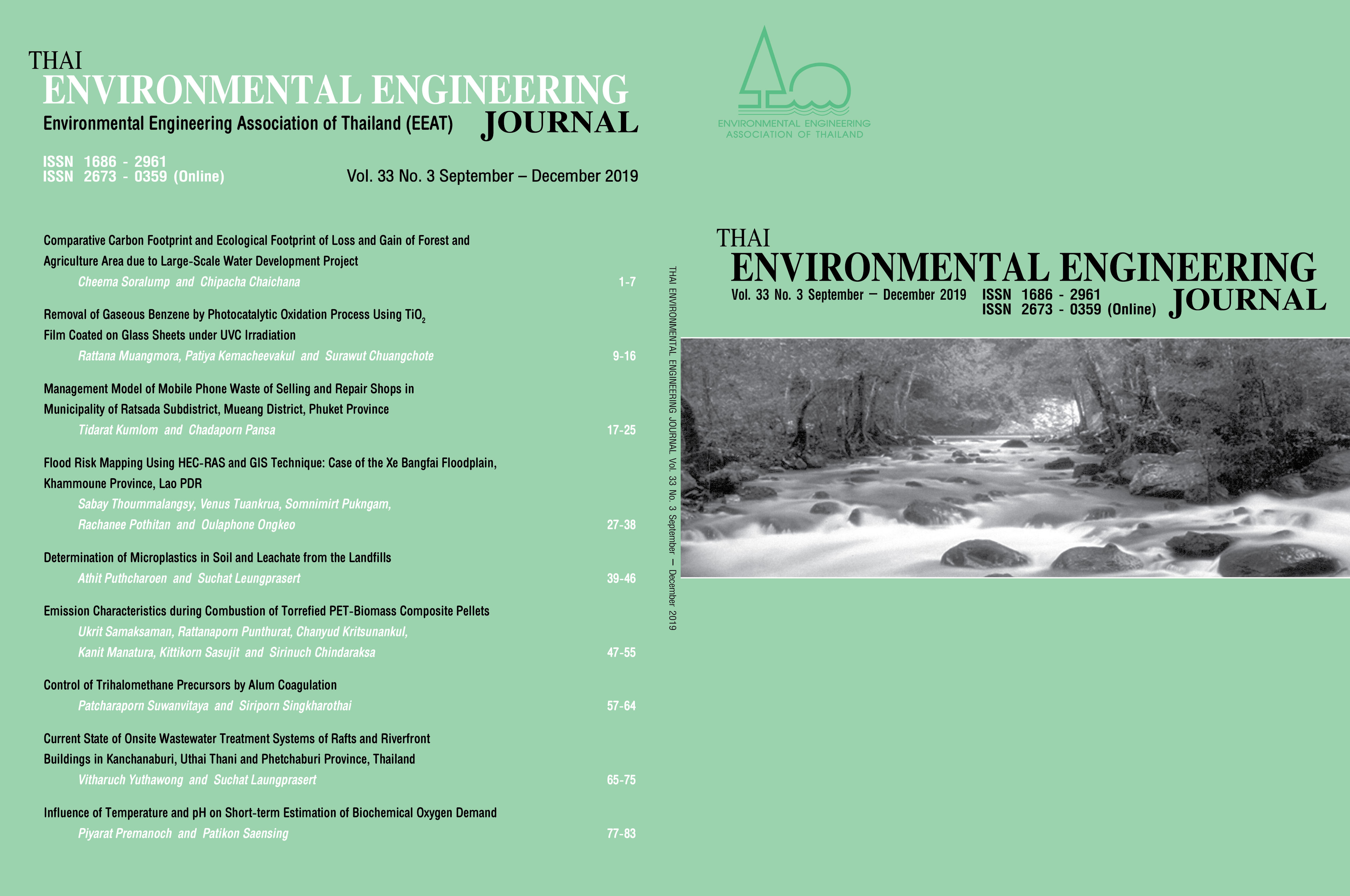Control of THMs Precursors by Alum Coagulation
Main Article Content
Abstract
Natural organic matters (NOM) contamination is a worrisome challenge to water treatment plants. The use of alum and alum with PAC are common in treating surface water for household consumption. This study investigated the effect of coagulation by alum and alum with PAC on NOM, focusing on organic fractions and trihalomethane formation potential (THMFP). Water sample was collected from raw water reservoir for Bangkhla water treatment plant. It was found to contain 21.78 mgDOC/L with hydrophilic (HPI) fraction of 58.26% and hydrophobic (HPO) fraction of 41.74%. The presence of NOM was confirmed by FEEM technique where humic –like, fulvic-like and tryptophan-like substances were detected. Coagulation using alum (60 mg/L) and alum with PAC (60 + 60 mg/L) gave comparable results. DOC removals of 38.48% and 39.36% and were achieved. The HPI and HPO fractions remained essentially the same as those of raw water. THMFP was reduced by 13.85 and 19.73%, respectively.
Article Details
References
[2] Zazouli, M.A., S. Nasseri, A.H. Mahvi, A.R. Mesdaghinia and M. Gholami, 2007. Study of natural organic matter fractions in water sources of TehranPak. J. Biological Science. 10: 1718-1722.
[3] Croue, J.P., E. Lefebvre, B. Martin and B. Legube, 1993. Removal of dissolved hydrophobic and hydrophilic organic substances during coagulation/flocculation of surface waters. Water Science and Technology. 27: 143-152.
[4] Singer, P.C., 1999. Humic Substances as precursors for potentially harmful disinfection by-products. Water Science and Technology. 40: 25-30.
[5] Kim, H.C. and M.J. Yu, 2005. Characterization of natural organic matter in conventional water treatment processes for selection of treatment processes focused on DBPs control. Water Research. 39: 4779-4789.
[6] Huang, W. and Yeh, H. 1997. The effect of organic characteristics and bromide on disinfection by-products formation by chlorination. J. Environmental Science and Health A32: 2311-2336.
[7] Zhang, H., Qu, J., Liu, H. and Wei, D. 2009. Characterization of dissolved organic matter fractions and its relationship with the disinfection by-products formation. J. Environmental Sciences. 21(1): 54-61.
[8] Roccaro, P. and Vagliasindi, F.G.A. 2009. Differential vs. absolute UV absorbance approaches in studying NOM reactivity in DBPs formation: Comparison and applicability. Water Research. 43(3): 744-750.
[9] Fabris, R., Chow, C.W.K., Drikas, M. and Eikebrokk, B. 2008. Comparison of NOM character in selected Australian and Norwegian drinking waters. Water Research. 42(15): 4188-4196.
[10] Wong, H., Mok, K.M. & Fan, X.J. 2007. Natural organic matter and formation of trihalomethanes in two water treatment processes. Desalination. 210(1-3): 44-51.
[11] Lu, J., Zhangm T., Ma, J. and Chen, Z. 2009. Evaluation of disinfection by-products formation during chlorination and chloramination of dissolved natural organic matter fractions isolated from a filtered river water. J. Hazardous Materials. 162(1): 140-145.
[12] Gregory, J., and Duan, J. 2001. Hydrolyzing metal salts as coagulants. Pure and Applied Chemistry. 73(12): 2017-2026.
[13] Fabris, R., Chow, C. W., Drikas, M., and Eikebrokk, B. 2008. Comparison of NOM character in selected Australian and Norwegian drinking waters. Water Research. 42(15): 4188-4196.
[14] Matilainen, A., Lindqvist, N., Korhonen, S., and Tuhkanen, T. 2002. Removal of NOM in the different stages of the water treatment process. Environment International. 28(6): 457-465.
[15] Park, K. Y., Yu, Y. J., Yun, S. J., and Kweon, J. H. 2019. Natural organic matter removal from algal-rich water and disinfection by-products formation potential reduction by powdered activated carbon adsorption. J Environmental Management. 235: 310-318.
[16] American Public Health Association. 2012. Standard Methods for the Examination of Water and Wastewater (22nd ed.). American Public Health Association, American Water Works Association and the Water Environment Federation, Washington DC.
[17] Chow, W.K., Fabris, R. and Drikas, M. 2004. A rapid fractionation technique to characterize natural organic matter for the optimization or water treatment processes. J. Water Supply : Research and Technology – Aqua. 53(2): 85-92.
[18] Zazouli, M.A., S. Nasseri, A.H. Mahvi, A.R. Mesdaghinia, Younecian, M. and M. Gholami, 2007. Determination of hydrophobic and hydrophilic fractions of natural organic matter in raw water of Jalalieh and Tehranspars water treatment plants (Tehran). J. Applied Science. 7 (18): 2651-2655.
[19] Fabris, R., Chow, C. W., Drikas, M., and Eikebrokk, B. 2008. Comparison of NOM character in selected Australian and Norwegian drinking waters. Water Research 42(15): 4188-4196.
[20] Panyapinyopol, B., Marhaba, T.F., Kanokkantapong, V. and Pavasant, P. 2005. Characterization of precursors to trihalomethanes formation in Bangkok source water. J. Hazardous Materials, B120: 229-236.
[21] Bieroza, M., Baker, A., and Bridgeman, J. 2009. Relating freshwater organic matter fluorescence to organic carbon removal efficiency in drinking water treatment. Science and Total Environment 407(5): 1765-1774.
[22] Dastgheib, S. A., Karanfil, T., and Cheng, W. 2004. Tailoring activated carbons for enhanced removal of natural organic matter from natural waters. Carbon. 42(3): 547-557.


